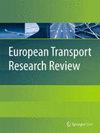实现更环保的城市物流:应用敏捷路由算法优化巴塞罗那微型枢纽的分布
IF 4.2
3区 工程技术
Q1 TRANSPORTATION
引用次数: 0
摘要
COVID-19 大流行加速了向网上购物的转变,重塑了消费者的习惯,加剧了对城市货运配送的影响。这种干扰加剧了城市交通拥堵和停车位短缺,凸显了对可持续配送模式的需求。欧盟的共同运输政策倡导创新的 UFD 方法,以促进多式联运、减少交通流量并优化货物装载。我们的研究针对这些挑战,为巴塞罗那的另一种 UFD 模式提出了一种灵活的路由算法。该模式建议从铁路设施、市场、购物中心、地区建筑、取货点、邮局和停车场(共 1057 个点)中选择具有战略位置的微型枢纽。它还通过货运自行车和电动货车促进多式联运。这项研究有两个主要目标:(i) 确定一个多式联运微型枢纽网络,以便在巴塞罗那高效投递包裹;(ii) 开发一种灵活的路由算法,优化微型枢纽的位置。该算法在考虑微型枢纽运营成本和车辆路由成本的基础上,采用启发式和机器学习方法,并通过并行化技术加以强化,生成自适应配送计划。它能根据交通基础设施、运输模式和配送地点迅速生成高质量的路由计划。该算法可动态调整,并采用多目标技术为每个计划建立帕累托前沿。在巴塞罗那使用实际数据进行的真实世界测试显示了良好的结果,提供了减少二氧化碳排放和缩短交货时间的潜在方案。因此,这项研究提供了一种创新的、可持续的 UFD 方法,将极大地促进城市实现更加绿色的未来。本文章由计算机程序翻译,如有差异,请以英文原文为准。
Towards greener city logistics: an application of agile routing algorithms to optimize the distribution of micro-hubs in Barcelona
The COVID-19 pandemic accelerated the shift towards online shopping, reshaping consumer habits and intensifying the impact on urban freight distribution. This disruption exacerbated traffic congestion and parking shortages in cities, underscoring the need for sustainable distribution models. The European Union's common transport policy advocates for innovative UFD approaches that promote intermodal transportation, reduce traffic, and optimize cargo loads. Our study addresses these challenges by proposing an agile routing algorithm for an alternative UFD model in Barcelona. This model suggests strategically located micro-hubs selected from a set of railway facilities, markets, shopping centers, district buildings, pickup points, post offices, and parking lots (1057 points in total). It also promotes intermodality through cargo bikes and electric vans. The study has two main objectives: (i) to identify a network of intermodal micro-hubs for the efficient delivery of parcels in Barcelona and (ii) to develop an agile routing algorithm to optimize their location. The algorithm generates adaptive distribution plans considering micro-hub operating costs and vehicle routing costs, and using heuristic and machine learning methods enhanced by parallelization techniques. It swiftly produces high-quality routing plans based on transportation infrastructure, transportation modes, and delivery locations. The algorithm adapts dynamically and employs multi-objective techniques to establish the Pareto frontier for each plan. Real-world testing in Barcelona, using actual data has shown promising results, providing potential scenarios to reduce CO2 emissions and improve delivery times. As such, this research offers an innovative and sustainable approach to UFD, that will contribute significantly to a greener future for cities.
求助全文
通过发布文献求助,成功后即可免费获取论文全文。
去求助
来源期刊

European Transport Research Review
Engineering-Mechanical Engineering
CiteScore
8.60
自引率
4.70%
发文量
49
审稿时长
13 weeks
期刊介绍:
European Transport Research Review (ETRR) is a peer-reviewed open access journal publishing original high-quality scholarly research and developments in areas related to transportation science, technologies, policy and practice. Established in 2008 by the European Conference of Transport Research Institutes (ECTRI), the Journal provides researchers and practitioners around the world with an authoritative forum for the dissemination and critical discussion of new ideas and methodologies that originate in, or are of special interest to, the European transport research community. The journal is unique in its field, as it covers all modes of transport and addresses both the engineering and the social science perspective, offering a truly multidisciplinary platform for researchers, practitioners, engineers and policymakers. ETRR is aimed at a readership including researchers, practitioners in the design and operation of transportation systems, and policymakers at the international, national, regional and local levels.
 求助内容:
求助内容: 应助结果提醒方式:
应助结果提醒方式:


